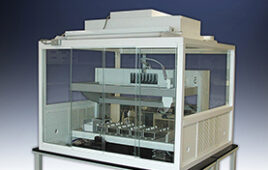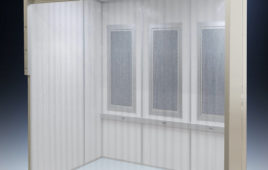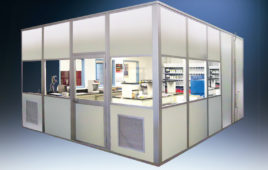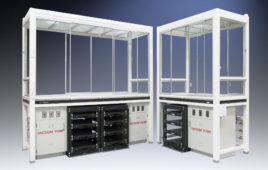Cleanroom gloves, a key consumable, are essential in managing and minimizing contamination in critical environments. This does not come as a surprise, as cleanroom gloves are among the very few consumables that come into direct contact with the product.
While different industries differ in their requirements of the type of gloves employed, there remains a similar goal: to reduce and minimize the source of contamination.
There are several factors that need to be taken into consideration when selecting the right pair of cleanroom gloves for the job.
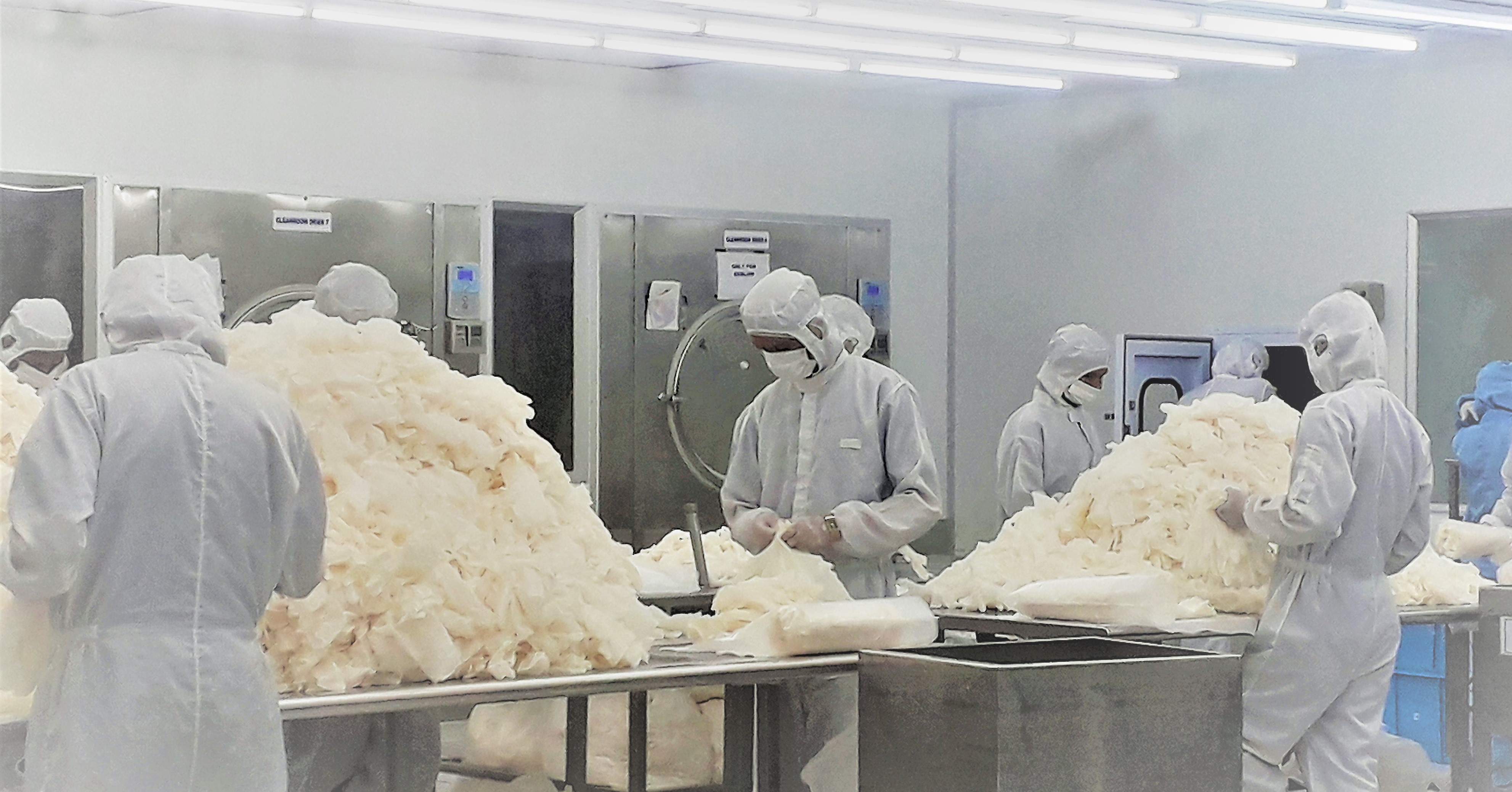
A cleanroom facility for packaging cleanroom gloves. Image: CE Technology Berhad
Cleanroom class requirements — understanding the processes and products involved
Understanding of cleanroom classifications, and the type of industry the gloves are being used for, will aid in better selection of cleanroom gloves.
Industries that employ critical environments may vary in their requirements and standards. For instance, in industries such as the semiconductor industry, there are several banned substances such as silicone, amide, and Dioctyl Phthalate (DOP) that manufacturers have to avoid.
Gloves used for critical environments in the pharmaceutical and life sciences industries may require additional chemical and microbiological hazard protection. Industry standards that dictate cleanroom classification (Class 1, Class 10, Class 100, Class 1,000, Class 10,000, and Class 100,000) will require considerations in the particulate count, nonvolatile, and ionic residues on surface of the gloves.
The most common glove materials used in cleanrooms include vinyl or PVC, natural rubber latex, and synthetic rubber latex. Each with its own merits, the type of glove material will be taken into consideration — of course, this depends on the processes, as well as the products that the gloves will come into contact with.
Vinyl or PVC gloves are typically employed in critical environments that are less sensitive to particle contamination, where the risk of biohazards are minimal.
Unlike vinyl or PVC gloves, natural rubber latex and synthetic rubber latex (nitrile, neoprene, polyisoprene, and polyurethane) offer the worker better protection from microbiological hazards, while at the same time maintaining a low particle count and low ionic residue. The ability of these gloves to be sterilized via gamma-irradiation allows them to be excellent candidates for use in aseptic critical environments.
Depending on the level of cleanroom classification required, synthetic latex gloves can undergo intensive post-processing to achieve very low particlecount and low ionic residue extracted — unlike natural rubber latex, which will be able to withstand only a certain amount of post-processing before inevitably shedding.
Physical properties of gloves
Cleanroom glove manufacturers today have adapted to the ever-evolving glove market across the world in catering to the needs of critical environments. Technology advancements have made headway for gloves to boast of a variety of new features and improved quality. Customers now have theluxury of selecting the right tackiness of the glove for the job; the overall feel in term of softness; and comfort, sizing, and the length of the glove required.
For minute and precision product handling, the right tackiness is essential for better grip and feel to benefit the worker.
The elongation, softness, and comfort of the glove play a great role when the overall experience and dexterity comfort of the worker is of concern. This prevents dexterity fatigue for users when working long hours in critical environments and cleanrooms.
Certain aseptic conditions of critical environments, such as the life sciences industry, may also require different lengths of gloves for the right amount of protection to the worker, as well as to minimize biological contaminant into a controlled environment.
The type of packaging and the sterility of the cleanroom gloves may also be a consideration, depending on working conditions.
Performance certifications
With the promise of a plethora of desirable features from cleanroom gloves, the reliability and the consistency of the gloves have to be in line with such expectations. Selecting reliable and reputable glove manufactures that uphold compliance to industry standards is essential in getting the right product that works for the end-user.
To ensure the performance of these gloves meet the industry requirements and are of the best quality, customers can look to international standards performance parameters such as IEST, ASTM, and EN when choosing cleanroom gloves for critical environments.
Considering the majority of cleanroom gloves used end up in fast-growing, high-end electronic industries, there is also a need for these gloves to exhibit good electrostatic discharge (ESD) qualities for static control and management.
ESD damage can incur billions of dollars’ worth of losses through product failure, loss of productivity, and yield. The constant miniaturization of electronic components poses a growing risk for damages; catastrophic or latent. This inevitably makes the need for good ESD protection gloves to be employed. However, ESD qualities in cleanroom gloves come at the expense of the cleanliness (in terms of particle count and extractable ionic residue) of the gloves.
Therefore, understanding the level of ESD protection necessary — as well as the level of cleanliness of the gloves required — would aid the selection of the gloves, while allowing manufacturers to strike the perfect balance for such products. The new market requirement for ESD cleanroom gloves to exhibit surface resistance below 1 x 109 ohms requires dedication from manufacturers to develop gloves that have intrinsically good ESD features able to withstand the intensive leaching and post-treatment processing of the manufacturing process — unlike the conventional topical treatment method of static dissipative chemical additives.
Identification of industry hazards
Chlorination is one of the major processes in glove manufacturing. It also plays a role in the post-processing of cleanroom gloves. Cleanroom glove manufacturers are now moving in the direction of reducing the halogen-levels in gloves by reducing or eliminating the chlorination process common to the manufacturing process of nitrile gloves.
This conscious effort of the glove manufacturing industry is in step with the global effort of “going green,” reducing the emission of hazardous waste materials to the environment. Identification of halogens as a hazard by the glove manufacturing industry may be a consideration for users when selecting cleanroom gloves for critical environments. Users can check for halogen-free compliance on the gloves through parameters of EN standards.
Furthermore, considerations in the compliance to California Proposition 65 safety regulation standard requirements has led to cleanroom gloves being manufactured without carcinogenic chemicals such as accelerators and other toxic chemicals as part of the vulcanizing process in manufacturing. This will reduce the concerns from users on the glove-related contact dermatitis, especially synthetic latex gloves with the improved formulations of new chemical additives.
With these considerations in mind, the selection process for the right pair of cleanroom gloves for the job can help industry professionals be better informed. Dedicated manufacturers must stay one step ahead while meeting the demands and standards of the industry through constant research and product development, by experimenting and exploring changes in the manufacturing processes and with new materials.
Heng King Wey, PhD, holds a doctorate in Biotechnology from Universiti Sains Malaysia. He is the Head of Research and Development for CE Technology Berhad, a cleanroom glove manufacturer. King is also an international member of the EOS/ESD Association Inc. www.ceglobal.com.my

